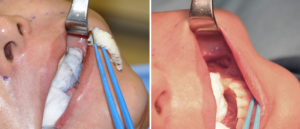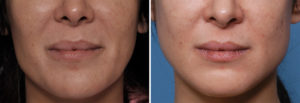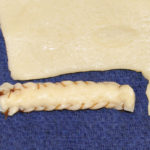Background: Asymmetry of the lower third of the face is common. While there can be a soft tissue component to it, more times than not it is caused by asymmetry of the bone. the most common location for jaw asymmetries is in the angle area. The mandibular ramus is the L-shaped portion of the jaw and is prone to differences between the two sides in length and/or width.
Jaw angle asymmetry is best appreciated from the front view. Patients particularly notice it in pictures where the face becomes ‘frozen’ and is most easily seen. But because everyone of us knows our faces so well (and more so today because of smart phones and selfies) patients can see it even when others can’t.
The treatment for a jaw angle symmetry due to a deficiency is an implant. Provided the location is known and the implant is the right shape and size, good correction can be expected. But not everyone likes the concept of an implant so alternative options may be considered.
Case Study: This 32 year-old female had a modest jaw angle asymmetry with a deficiency on her left side. The inferior border along the angle lacked the fullness and jawline that the opposite side had. She preferred to use a more ‘natural’ material rather than an implant.


An allogeneic dermal graft would not ordinarily be a preferred facial bone augmentation material. It is a soft tissue augmentation material that purportedly is integrated into the recipient site and replaced by natural tissue. (scar) In my experience it more often behaves like an implant and becomes a well tolerated tissue filler with some fibrovascular ingrowth. For minor facial bone asymmetries where an implant is not preferred, these dermal products can be an option to consider.
Highlights:
1) Lower facial asymmetry is most commonly caused by a bony asymmetry of the jaw.
2) Jaw angle asymmetries can be treated by a variety of implant materials placed on the bone.
3) For patients wary of synthetic implants on the jawline, an allogeneic dermal graft can be used for smaller jaw asymmetries.
Dr. Barry Eppley
Indianapolis, Indiana



